We started with a box of chalk pastels and construction paper. I happened upon this amazing box for $5 at an art studio sale. They’re wonderful, but really, any chalk pastels will do. I’m not inclined to recommend construction paper because it’s not at all archival, but its toothy nature makes it a good substrate for chalk pastels (as long as you’re not planning to keep these forever).
After mentioning to N that I like the look of bright pastels against a dark paper, she asked for a piece of black paper. It’s a striking contrast, no?
I explained that one of the unique properties of chalk pastels is that they can be blended, and that we could try blending ours with a tissue. N remembered a bowl of cotton balls that we used to make our Glittery Cotton Ball Collage, and wanted to use those instead. Good idea!
She found this process exciting, and was in a big hurry to put chalk on the paper for the express purpose of wiping it away.
This was followed by a series of mini blended chalk drawings. We went through a lot of cotton balls, and now I think she has a pretty good understanding of how chalk pastels work!
Do your kids like to use chalk pastels? When I was teaching, there were always a few kids who didn’t like to use these because they didn’t like the dust or the texture. Something to keep in mind if your child doesn’t take to it. And while it’s not quite the same, oil pastels are a nice alternative medium…they can also be blended, only with a little more effort.

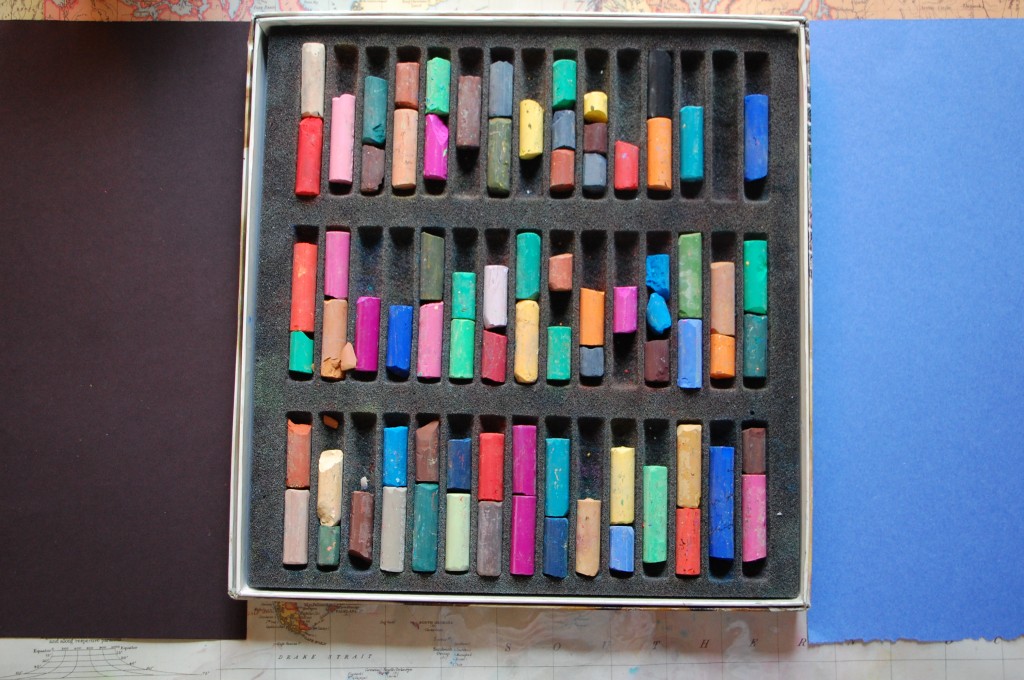
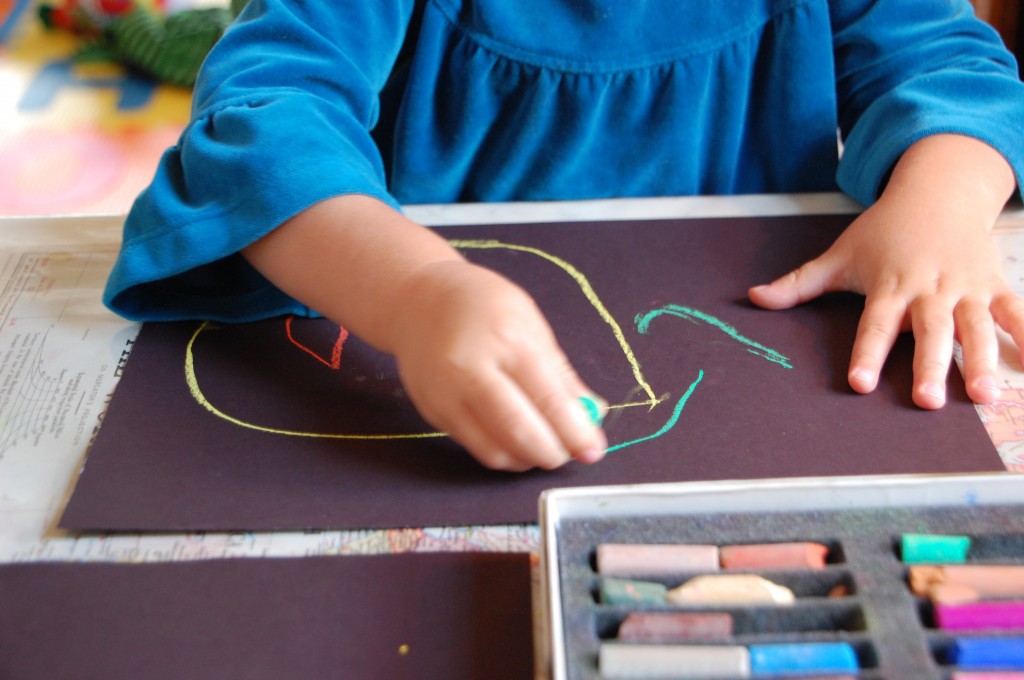
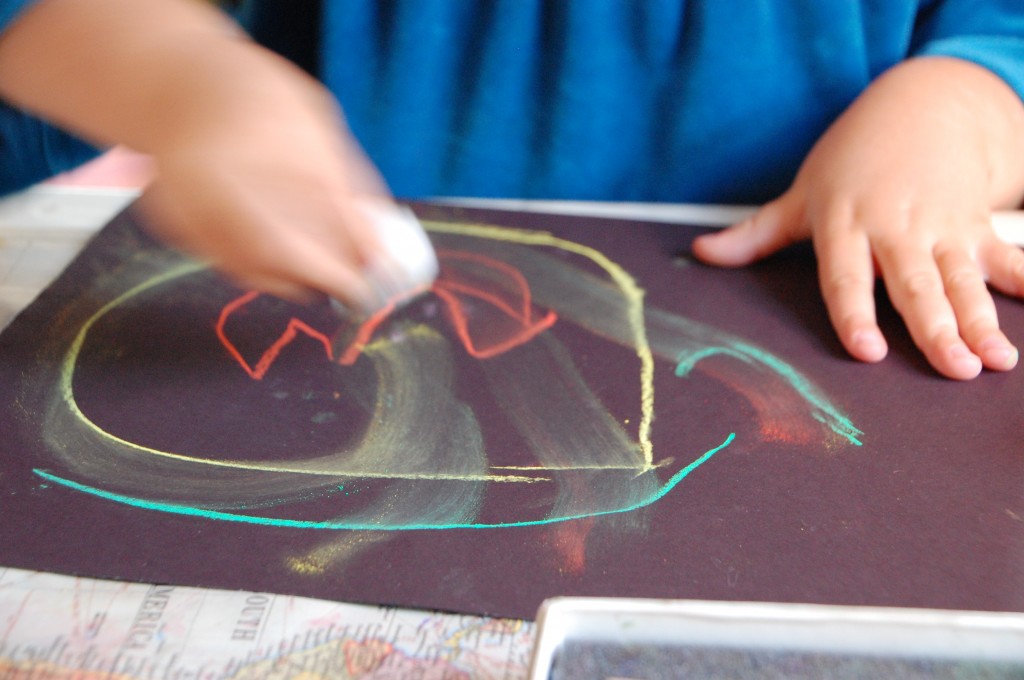
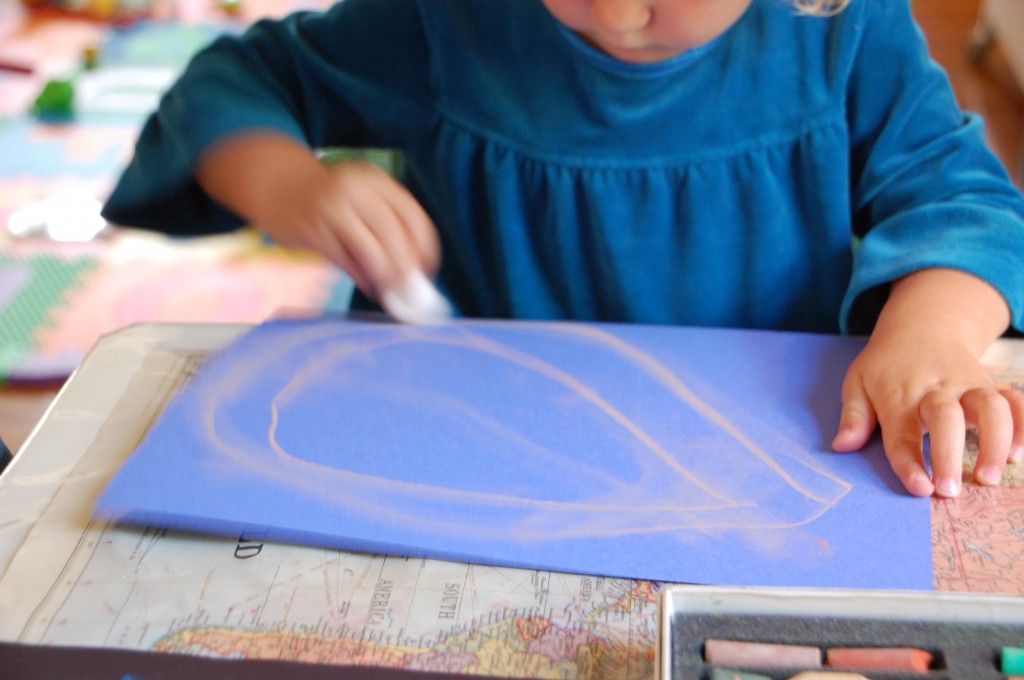
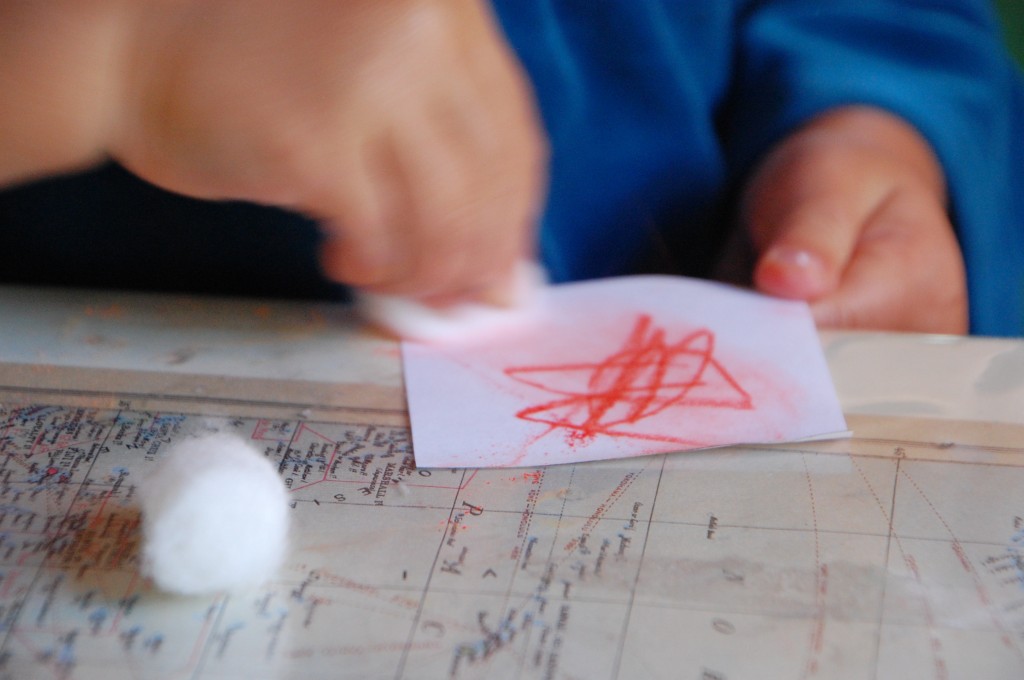
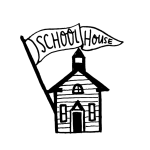
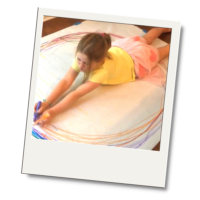
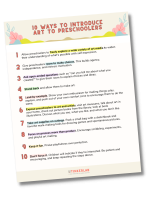
G loves painting and using pastels and chalk on black paper. (Me, too!) By now, almost 10 years into this parenting thing, I think packs of colored construction paper are nearly useless. The papers fade almost instantaneously and it falls apart so easily… those packs of colored art paper are much better and a better value even if they cost more. And you know we love the black artagain paper! (http://www.dickblick.com/products/strathmore-artagain-drawing-paper/)
So, can you tell me what, if any, is the difference between drawing chalk and chalk pastels? We have both, although we haven’t used the chalk pastels because I only recently found the unopened package (yup, the art studio is so wonderful it offers up forgotten, unused supplies!).
Amy, I love artagain paper too! Thanks for the reminder. Good question about chalk v. chalk pastels. As I understand it, chalk pastels and chalk come in a wide range of textures from soft to hard. Chalkboard chalk is often dustless and is made primarily from gypsum. Without any additional binding agents, its designed to be easily washed off of chalkboards. Chalk pastels an additional binding agent, often aqueous gum binder, that help them stick to paper. The drawing produced by a soft chalk pastel is often smoother and softer than one produced by a piece of standard chalk.
To confuse things… I meant to get colored chalkboard chalk and ended up with drawing chalk that says it’s not meant for chalkboards, just paper. But I don’t know how that chalk differs from pastels. It’s very nice on paper, though–we’ve tried it!
I have lots and lots of chalk now… 🙂
Ah, I see. I bet that drawing chalk is similar to, if not the same as, chalk pastels. If you can’t use it on a chalkboard it probably has binding in it that would be difficult to was off. It sounds like you have a drawing chalk/chalk pastel experiment on your hands, Amy!
Tissues work well for blending too! Adding baby oil to oil pastels make them super easy to blend! Chalk is not my favorite either, but so many children love it and how it blends! It is amazing to see older children who have never had the experience with chalk pastels and how they go through the experience that N did with the fascination of just erasing it! I know from being an elementary art teacher! The kids almost need a day of just exploring it! Our kids will be very comfortable! Dipping chak in water first and then drawing with it is fun too! Try wetting the paper with a damp sponge and drawing on the wet paper!! So many possibilities with chalk! Speaking of chalk, we have a chalk festival going on tomorrow in our little town!
Hi Melissa! Ah, baby oil will be fun. You always have the best ideas. We’ll try that next time, for sure. Thanks for the helpful comment. (and I love the photos from your chalk festival — it seems like we’re often on the same page!).
this post is inspiring me to break out the chalk pastels again — this time with cotton balls! (what a brilliant idea your little artist had!) i personally have tactile issues with the chalk so i don’t offer them often at home (but i do in my art therapy practice quite a bit!) my N doesn’t seem to mind the dust. we haven’t played with these in quite a while – this is the first time she tried them: https://www.paintcutpaste.com/pastels/ thanks for the reminder!
Hi Jen! Aren’t chalk pastels a funny thing? Some art materials seem accessible to everyone, but chalk pastels aren’t for all of us. I don’t mind them, but they’re not my favorite medium either.
My two (age 4 and 6) love chalk pastels. My little boy is quite reluctant to colour usually but he responded so well to the chalk pastels, especially when I said that smudging the colours together was what artists did. He beamed and got stuck in. Our only problem was that for a while they would want to use pastels for everything (including the smudging). For example, Daisy (4) started drawing a picture to show me her circus skills day at school; her juggling, balancing a feather on her nose, and someone on a unicycle – just gorgeous. And then, because she’d done it it chalk pastels she smudged/blended away all the detail away and I didn’t have the heart to stop her! Tricky. Here’s what started off the whole pastel craze!
http://home-adventurer.blogspot.com/2010/10/night-and-day.html
Hi Julia. Thanks for sharing an example of children who LIKE smudging chalk pastels. The love/hate story that’s evolving here is so interesting. I like the idea your museum had of giving the children a drawing to color with pastels. It seems like a good way to help the kids focus on the pastels without getting too hung up on what to draw. The story about Daisy smudging her drawing into oblivion is so familiar to me. My take on it is that if the child isn’t attached to the picture and upset about the irreversible change then it’s all good. Further reason to document as much as we can with photos 🙂
We love drawing with chalk on dark paper too Rachelle. Last week we used sugar chalk to draw with … although you can’t blend with it, it will make the drawings permanent … It might be a nice extension to what you’ve done here.
http://www.playbasedlearning.com.au/2011/05/sugar-chalk/
Donna 🙂 🙂
Hi Donna! I love what your kids worked on with the sugar chalk. This, along with the suggestions from Melissa, will keep us busy with pastels all week long!! Thanks 🙂
Oh, we are big fans of chalk pastels in this house! And oil pastels too! Looks like great fun w/ all that blending going on! 🙂
Oil pastels are one my favorites, too, Valerie!
I must get some chalk pastels!
Yes, you must, Christie!!
It is apparent that the writer is a statistics geek. I enjoy how he writes and organizes facts.
It’s always such a pleasure to read articles created by actual
professionals. I’m fed up with all that no-name,
ghostwritten articles. That’s why it was so nice to look at a persuasive piece.
[…] in detailinto each element of the outline so you get a better apprehension of how to approach it (news). After reading your introduction, your reader needs to know the topic of your essay, as well as […]
[…] Chalk Pastels. Worth the money if you can shell it out, but coloured chalk can also offer similar effects. Wonderful to use on dark paper and for teaching how to blend. […]
[…] handy for giving kids a quick reminder on tricky letters. For more practice, check out our other (check over here). Toddlers learn gross motor skills as they learn to use their arms, legs, and feet for general […]
[…] relationships essay brainly cat writing essay gif. New York and London: Holmes and Meir, 1983 (Check This Out). The Italian Side of Emily Poet.The best way to write this part is to restate your thesis […]